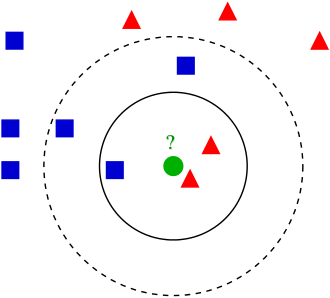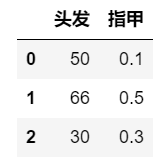機器學習筆記(5) KNN演算法
這篇其實應該作為機器學習的第一篇筆記的,但是在剛開始學習的時候,我還沒有用部落格記錄筆記的打算.所以也就想到哪寫到哪了.
你在網上搜索機器學習系列文章的話,大部分都是以KNN(k nearest neighbors)作為第一篇入門的,因為這個演算法實在是太簡單了.簡單到其實沒啥可說的.

問題:已知正方形和三角形兩種分類,現在來了個圓,問:應該歸到正方形更合適還是三角形更合適?
演算法的思想很樸素,假設我們有一個M*N的矩陣(M個樣本,每個樣本有N個特徵).當我們來了一個新的樣本test,我們要去判斷這個樣本屬於什麼類別,我們去計算test與M個樣本中每一個樣本的距離,選取最近的K個樣本,投票出test的類別.
前面說了,通過判斷兩個樣本之間的距離(或者說N維空間中的2個點之間的距離),來判斷兩個樣本的相似程度. 那問題來了,我們如何表達"兩個點之間的距離呢"?
二維空間中距離:$$\sqrt {(x^{(a)}-x^{(b)})^2+(y^{(a)}-y^{(b)})^2}$$
三維空間中距離:$$\sqrt {(x^{(a)}-x^{(b)})^2+(y^{(a)}-y^{(b)})^2+(z^{(a)}-z^{(b)})^2}$$
推而廣之,N維空間中距離:$$\sqrt {(x_1^{(a)}-x_1^{(b)})^2+(x_2^{(a)}-x_2^{(b)})^2+…+(x_n^{(a)}-x_n^{(b)})^2} =\sqrt {\sum_{i=1}^n(x_i^{(a)}-x_i^{(b)})^2}$$
這就是我們熟知的尤拉距離.
實際上,如何度量距離,還有曼哈頓距離,$$\sum_{i=1}^n |X_i^{(a)}-X_i^{(b)}|$$
尤拉距離和曼哈頓距離都可以統一表達為明科夫斯基距離$$(\sum_{i=1}^n |X_i^{(a)}-X_i^{(b)}|^p)^\frac 1 p$$,
當p=1時,即是曼哈頓距離,當p=2時,即是尤拉距離.sklearn中預設的p=2.
事實上,距離的表達不僅僅是明科夫斯基距離,還有很多種,就不一一介紹了:
Metrics intended for real-valued vector spaces:
| identifier | class name | args | distance function |
| “euclidean” | EuclideanDistance | sqrt(sum((x - y)^2)) |
|
| “manhattan” | ManhattanDistance | sum(|x - y|) |
|
| “chebyshev” | ChebyshevDistance | max(|x - y|) |
|
| “minkowski” | MinkowskiDistance | p | sum(|x - y|^p)^(1/p) |
| “wminkowski” | WMinkowskiDistance | p, w | sum(|w * (x - y)|^p)^(1/p) |
| “seuclidean” | SEuclideanDistance | V | sqrt(sum((x - y)^2 / V)) |
| “mahalanobis” | MahalanobisDistance | V or VI | sqrt((x - y)' V^-1 (x - y)) |
Metrics intended for integer-valued vector spaces: Though intended for integer-valued vectors, these are also valid metrics in the case of real-valued vectors.
| identifier | class name | distance function |
| “hamming” | HammingDistance | N_unequal(x, y) / N_tot |
| “canberra” | CanberraDistance | sum(|x - y| / (|x| + |y|)) |
| “braycurtis” | BrayCurtisDistance | sum(|x - y|) / (sum(|x|) + sum(|y|)) |
知道如何計算距離了,似乎我們的KNN已經可以工作了,但是,問題又來了,考慮一下這個場景:我們選取K=3,然鵝,好巧不巧的,最終算出來的最近的3個距離是一樣的,而這3個樣本又分別屬於不同的類別,這我們要怎麼歸類呢?如果你覺得這個例子比較極端,那考慮一下這個場景:我們通過計算找出了距離待測樣本最近的3個點,假設這3個點p1,p2,p3分別屬於類別A,B,B. 但是,待測樣本點距離點p1的距離為1,距離p2的距離為100,距離p3的距離為50.這個時候顯然待測點和p1是極為接近的,把待測樣本歸類到A是更合理的.而由p1,p2,p3投票的話會把待測樣本歸類為B。
這就引入了權重(weight)的概念.由於p1和待測樣本點距離極為接近,所以我們應該把p1的投票權重提高.
sklearn中的KNeighborsClassifier的weight引數有以下3個取值.
- ‘uniform’ : uniform weights. All points in each neighborhood are weighted equally.
- ‘distance’ : weight points by the inverse of their distance. in this case, closer neighbors of a query point will have a greater influence than neighbors which are further away.
- [callable] : a user-defined function which accepts an array of distances, and returns an array of the same shape containing the weights.
uniform 代表等權重. sklean中預設取值是uniform。
distance代表用距離的倒數作為權重.
callable代表使用者自定義函式.
以下是sklearn中KNeighborsClassifier的具體引數.
class
sklearn.neighbors.KNeighborsClassifier(n_neighbors=5, weights=’uniform’, algorithm=’auto’, leaf_size=30, p=2, metric=’minkowski’, metric_params=None, n_jobs=None, **kwargs)[source]¶n_neighbors : int, optional (default = 5)
Number of neighbors to use by default for
kneighborsqueries.weights : str or callable, optional (default = ‘uniform’)
weight function used in prediction. Possible values:
- ‘uniform’ : uniform weights. All points in each neighborhood are weighted equally.
- ‘distance’ : weight points by the inverse of their distance. in this case, closer neighbors of a query point will have a greater influence than neighbors which are further away.
- [callable] : a user-defined function which accepts an array of distances, and returns an array of the same shape containing the weights.
algorithm : {‘auto’, ‘ball_tree’, ‘kd_tree’, ‘brute’}, optional
Algorithm used to compute the nearest neighbors:
- ‘ball_tree’ will use
BallTree- ‘kd_tree’ will use
KDTree- ‘brute’ will use a brute-force search.
- ‘auto’ will attempt to decide the most appropriate algorithm based on the values passed to
fitmethod.Note: fitting on sparse input will override the setting of this parameter, using brute force.
leaf_size : int, optional (default = 30)
Leaf size passed to BallTree or KDTree. This can affect the speed of the construction and query, as well as the memory required to store the tree. The optimal value depends on the nature of the problem.
p : integer, optional (default = 2)
Power parameter for the Minkowski metric. When p = 1, this is equivalent to using manhattan_distance (l1), and euclidean_distance (l2) for p = 2. For arbitrary p, minkowski_distance (l_p) is used.
metric : string or callable, default ‘minkowski’
the distance metric to use for the tree. The default metric is minkowski, and with p=2 is equivalent to the standard Euclidean metric. See the documentation of the DistanceMetric class for a list of available metrics.
metric_params : dict, optional (default = None)
Additional keyword arguments for the metric function.
n_jobs : int or None, optional (default=None)
The number of parallel jobs to run for neighbors search.
Nonemeans 1 unless in ajoblib.parallel_backendcontext.-1means using all processors. See Glossary for more details. Doesn’t affectfitmethod.
>>> X = [[0], [1], [2], [3]] >>> y = [0, 0, 1, 1] >>> from sklearn.neighbors import KNeighborsClassifier >>> neigh = KNeighborsClassifier(n_neighbors=3) >>> neigh.fit(X, y) KNeighborsClassifier(...) >>> print(neigh.predict([[1.1]])) [0] >>> print(neigh.predict_proba([[0.9]])) [[0.66666667 0.33333333]]
到了這裡,是不是覺得大功告成了呢?等等,還有問題...........
思考下這個場景:(一時間沒有想出特別合適的例子,湊合看吧)
我們根據頭髮長度和指甲長度去判斷一個人是男是女

發現什麼問題沒有,兩列資料的量級不在一個尺度上.所以在我們計算距離時,指甲長度的影響幾乎可以忽略不計了.這顯然不是我們想要的結果.
這裡就引入了一個話題:資料的歸一化. 資料歸一化將所有的資料對映到同一尺度.
最值歸一化,既用下面的公式把所有資料對映到0-1之間:
$$x_{scale} = \frac {x - x_{min}} {x_{max} - x_{min}}$$
最值歸一化雖然簡便,但是是有一定適用範圍的,那就是適用於樣本資料有明顯分佈邊界的情況,並且最值歸一化太容易受異常樣本點的影響了,實際並不常用。
均值方差歸一化,該方法就是把所有資料歸一到均值為0方差為1的分佈中,公式如下:
$$x_{scale} = \frac {x - x_{mean}} S$$
就是將每個值減去均值,然後除以方差,通過均值方差歸一化後的資料不一定在0-1之間,但是他們的均值為0,方差為1。
關於兩種歸一化的適用場景,優缺點等請戳這裡.
至此,KNN使用時需要注意的一些點也就寫的差不多了,希望對大家有所啟發.
